17 Ancient Rome
The Etruscans
Italy as a unified country did not exist until the 19th century. The area we know as Italy, or the boot-shaped peninsula that extends into the Mediterranean Sea was originally colonized by peoples from Greece, areas from around the Mediterranean and other areas from the North including the Celts. By the 6th c. BCE a group known as the Etruscans had gained control of much of the north and central Italy. The Etruscan society was largely centered on Etruria (modern Tuscany) but would eventually rule the little Latin-speaking town on the Tiber River, Rome. With the rise of Romans, the Etrurians were assimilated into that larger body that would go on to be the largest Empire of the early Common Era.
Key Points
- Etruscans were originally located in what is present-day Tuscany.
- Much of Etruscan architecture was inspired by ancient Greece.
- They were both an agrarian and sea-faring people trading with the Greeks and Phoenicians.
- Women in Etruria were given a position of greater equality than had been those of ancient Greece.
- Etruscans incorporated Greek deities and elements of Greek temple architecture.
- Etruscan cemeteries (necropolis – city of the dead) were planned like urban cities with tomb chambers or tumula partly carved from the local limestone.
Key Terms
- Atrium – a shallow indoor pool for household uses that collected rainwater through an opening in the roof.
- Prostyle – a style of temple with a row of columns across the front.
- Tuscan order – Vetruvius described this sturdy, unfluted column with a pedestal, base, and cornice, capital and entablature as coming from the Etruscan-modified Doric order.
- Archaic smile – as in the early Greek koroi; a small up-turning of the corners of the mouth, apparently to signify life.
- Sarcophagi – coffins or “eaters of the dead”. Etrurian sarcophagi were often made of terra-cotta.
- Apotropaic – meant to ward off evil, protective images.
The Etruscan peoples were originally the most successful of the early populations of what is today Italy. The height of the civilization was around 900–27 BCE. They were a highly organized society with a religion gleaned largely from the Greek pantheon and a government that would be something of a model for the early Romans. The first Roman kings were from Etruscan heritage.
The Etruscans had a written language that seems to have been based on early Greek. It has not been entirely translated by modern scholars and so much of what can be known about the early Etruscans is through the objects they left behind and from a few oblique historical references. The objects that have been recovered from places like the necropolises of Cerveteri and Veii.

The Etruscans built walled cities and houses of mud brick that were probably square. The tombs in the cities they built for their dead were elaborate and seem to have echoed the interior decoration of their homes. The tumuli tombs were mounds over chambers carved into the dark limestone of the region.
The Etruscans were also navigators of the seas surrounding the Italian peninsula trading with the advanced cultures of Greece, the islands, and areas further to the north and south. They were adept at bronze work and created sculpture, practical implements and weapons for exchange in trade. Etruscans built their cities on high places, which is not uncommon in areas vulnerable to attack across the land. Early Rome seems to have been built on the Etruscan model with the seven hills proving an optimum site.
They had an organized system of governance, the groups were still individual city-states although there is evidence that some of these organized themselves into a confederation or league at one point with a more centralized rule. Because trade was so lucrative, families could accrue wealth and so move up in the social construct of the city. That family life was central to the Etruscans is evidenced by the multiple members buried in the tombs and that they were wealthy by the burial goods placed with them. There is something of an Egyptian quality to the focus on burial places and goods in the Etruscan necropolis.

The prominence of the names of mothers and the picturing of the wives on sarcophagi may indicate that they enjoyed a greater degree of freedom and significance than did the more sequestered women of Greece. Greek women could never have attended symposia, or social gatherings like the one pictured here.

The image most suggestive of this is the Sarcophagus of the Spouses which is a terra-cotta burial casket decorated with the images of the couple that occupy it, or that is the implication. The couple is shown reclining in the sort of posture that later Romans will adopt for social occasions. Their hands suggest they might originally have held cups or eating utensils as if they were at a banquet. This sort of social freedom was not allowed Greek women; Theopompus, a Greek historian of the fourth century BCE, commented on the scandalous behaviour of the Etruscan women although he also commented that they were all very good looking.
Etruscan Temples
As with many aspects of Etruscan life, Greek models are suggestive but with significant differences. Firstly, Etruscan temples, like their homes, were made of mud brick instead of marble or stone. This means that unlike the Parthenon history has no examples remaining of actual Etruscan temple architecture. However, Vetruvius, a 1st c. BCE Roman writer, architect, and engineer, gave an account of the Etruscan temple in his De Architectura.
According to Vitruvius the temples had a wooden structure with mud brick walls which were then covered in stucco which could be painted or polished. Two rows of columns stood across the front porch (or pronaos) and were usually made of painted wood, although a temple at Veii had marble columns. There was a central staircase approach. There might be more than one cella, or interior space, on a tufa foundation. The tufa foundation you see in the image above is what remains of an Etruscan temple at Orvieto. While Greek temples tended to be rectangular the Etruscan model was more square in configuration.
Etruscan temples had low wooden roofs covered in tile that extended beyond the foundation. This created some protection from the elements for the mud brick structure. Unlike Greek temples with relief carving primarily reserved for the pediment and entablature areas, Etruscan temples had akroteria on the roofline which added to the visibility of the sculpture.
Like most sculpture of the ancient world, this would have been painted in bright colors. The Apulu (Apollo) of Veii is a terra cotta figure that would have been affixed to the roofline of the temple. According to Barbara Borg, the statue may have been made by the artist known as Vulca, the only Etruscan artist known by name. Note the dynamic striding posture of the figure with drapery that falls in stylized decorative folds. His lyre sits between his feet and he wears the archaic smile that signified life.
Other stone carvings called antefixes stood at the ends of the wooden roof beams offering some physical protection to the organic materials. They were often carved to represent the god Dionysus or Medusa, the Gorgon – apotropaic figures meant to offer spiritual protection from evil.

Etruscan Tombs
Etruscan tombs are sophisticated and complex structures which are very suggestive of the outlook on life and death shared by that culture. Like other ancient peoples the Etruscans created special “cities of the dead” (necropolises) outside the walls of the cities of the living, but arranged them both outside and in to mirror the places they had occupied while alive. The tumulus, or mound, of the tombs stood over multichambered depressions or rooms cut out of the tufa, a kind of local limestone. These tombs could cover a very large area and are thought to have housed the remains of generations of entire families. The tombs were laid out in an orderly manner like streets in a literal city. A number of these necropolises have been discovered, among them the large one of Banditaccia which contains several significant structures.
Tomb of the Reliefs
Built in the Banditaccia necropolis at Cerveteri, Italy, during the late fourth or early third century BCE, the Tomb of the Reliefs has walls decorated with painted relief sculpture of the household items that would have been found in an Etruscan home. The knives, jugs, lengths of rope and other domestic items suggest that the Etruscans shared the desire of the Egyptians to continue their earthly lives in their next. Religious imagery is also included is the three-headed dog – Cerberus – under the carved relief of a funeral couch. Cerberus was the guardian of the gate to the underworld, a reference to passage from one life to the another.


Tomb of the Leopards
Like the Egyptians, Etruscans painted scenes of activities from life on the walls of their tombs. In the Tomb of the Leopards from the necropolis at Monterozzi in Tarquinia, Italy, c. 480 BCE, an elaborate banquet scene decorates the room. Male figures – signified by dark skin – and females – light skin – recline on couches while musicians play and servants bring food and drink. On the pediment above them on the back wall of the tomb a pair of leopards face each other like the guardians of ancient gates and temples. One couple shows a man holding up an egg, a symbol of regeneration or renewed life. The figures interact in lively poses with composite bodies in both profile and frontal positions. The eyes, however, are depicted in profile, unlike those of the Egyptian figures and the plant life that surrounds them suggests a garden party. The colors are a reddish brown, blue, and crème with black outlines. Two figures have blonde hair while all the rest are dark.
End of the Etruscans
The eventual dominance of Rome spelled the end of the Etruscan wealth and society. The people and their art continue but under the rule of the Romans and in the service of that culture. One of the objects from this later period of Etruscan art is the Capitoline Wolf, ca. 500-480 BCE. Some scholars suggest this work is not Etruscan and the two infants, Romulus and Remus, were definitely created during the 15th century. But most agree this represents an Etruscan workshop at the height of its powers, even if the subject belongs to the origin story of their successors.

Sources for this section
Kleiner, Fred S. Gardner’s Art Through the Ages: a Global History, 15th ed. Cengage Learning, 2014.
Stokstad, Marilyn et al. Art History, Prentice Hall, Inc., and Harry N. Abrams, Inc., 1995.
Boundless Art History, https://courses.lumenlearning.com/boundless-arthistory/chapter/early-etruscan-art/, accessed Sept. 2020.
The Romans
Rome was founded in the mid-eighth century BCE by eight tribes who settled in Etruria and on the famous Seven Hills. The early inhabitants were called “Etruscans” and the present day area is called “Tuscany” after them.
Key Points
- The foundation myths of Romulus and Aeneas are the most common means of recounting the founding of Rome, and ancient historians used them to justify their often violent and warlike culture. However, the historical record provides a more reliable story. April 21, 753 BCE, is the date given by ancient Roman historians to the founding of Rome. Archaeological research supports this assertion, confirming that the site of Rome was inhabited by the mid-eighth century BCE.
- The Romans were descended from the Italic tribes, mainly the Latins (originally from the Alban Hills to the southeast) and the Sabines (originally from the Apennines to the northeast).
- What was to become Rome originally existed as a collection of autonomous villages atop each of the city’s famous Seven Hills. The Palatine Hill, located at the city center, marked the original settlement of the Romans, as well as significant temples and religious festivals. The Quirinal Hill became the home of the Sabines until the sixth century BCE, as well as the sites of significant temples and sanctuaries.
- Septimontium: A festival celebrating the first federation of the Seven Hills of Rome.
- wattle-and-daub: A composite building material used for making walls, in which a woven lattice of wooden strips are coated with a sticky material usually made of some combination of wet soil, clay, sand, animal dung and straw.
Foundation Myths
The Romans relied on two sets of myths to explain their origins: the first story tells the tale of Romulus and Remus, while the second tells the story of Aeneas and the Trojans, who survived the sack of Troy by the Greeks. Oddly, both stories relate the founding of Rome and the origins of its people to brutal murders. Romulus killed his twin brother, Remus, in a fit of rage, and Aeneas slaughtered his rival Turnus in combat. Roman historians used these mythical episodes as the reason for Rome’s own bloody history and periods of civil war. While foundation myths are the most common vehicle through which we learn about the origins of Rome and the Roman people, the actual history is often overlooked.
The Historical Record
Archaeological evidence shows that the area that eventually became Rome has been inhabited continuously for the past 14,000 years. The historical record provides evidence of habitation on and fortification of the Palatine Hill during the eighth century BCE, which supports the date of April 21, 753 BCE, as the date that ancient historians applied to the founding of Rome in association with a festival to Pales, the goddess of shepherds. Given the importance of agriculture to pre-Roman tribes, as well as most ancestors of civilization, it is logical that the Romans would link the celebration of their founding as a city to an agrarian goddess.
Romulus, whose name is believed to be the namesake of Rome, is credited for Rome’s founding. He is also credited with establishing the period of monarchical rule. Six kings ruled after him until 509 BCE, when the people rebelled against the last king, Tarquinius Superbus, and established the Republic. Throughout its history, the people—including plebeians, patricians, and senators—were wary of giving one person too much power and feared the tyranny of a king.
Roman Society
Ancient Roman society was based on class-based and political structures, as well as by religious practices.
Key Points
- Roman society consisted of several divisions of social classes that held varying degrees of power and prestige. This structure was echoed on a familial level under the power of the father, or pater familias.
- In matters of government, the Senate remained a fixture from the founding of Rome to the collapse of the Empire, although its power and influence grew and weakened over time.
- As Rome became a global power, its government consisted of levels on the colonial and municipal levels, as well as on the central level in the imperial capital.
- The Roman pantheon of gods is comparable to its Greek counterparts, who Romans worshiped and sent prayers to throughout their lives. The Romans were flexible in their worship and absorbed foreign gods into their pantheon.
- In the Imperial period, an imperial cult developed to worship the emperors who were deified upon their death.
Key Terms
- Pontifex Maximus: The official head, or chief priest, of the Roman state’s religion. In Imperial Rome this title and office was given to the Emperor.
- plebeian: A free Roman citizen who was not a patrician.
- equite: The lower of the two aristocratic classes of ancient Rome, ranking below the patricians.
- pater familias: The father, or (male) head of household.
- insula: An apartment building that housed most of the urban citizen population of ancient Rome, including ordinary people of lower- or middle- class status (the plebians) and all but the wealthiest from the upper-middle class (the equites).
- patrician: A member of a hereditary ruling-class family.
Social Structure
Life in ancient Rome centered around the capital city with its for a (plural for forum or civic center), temples, theaters, baths, gymnasia, brothels, and other forms of culture and entertainment. Private housing ranged from elegant urban palaces and country villas for the social elites to crowded insulae (apartment buildings) for the majority of the population.The large urban population required an endless supply of food, which was a complex logistical task. Area farms provided produce, while animal-derived products were considered luxuries. The aqueducts brought water to urban centers, and wine and oil were imported from Hispania (Spain and Portugal), Gaul (France and Belgium), and Africa. Egypt became known as the breadbasket of Rome.
Highly efficient technology allowed for frequent commerce among the provinces.While the population within the city of Rome might have exceeded one million, most Romans lived in rural areas, each with an average population of 10,000 inhabitants.
Roman society consisted of patricians, equites (equestrians, or knights), plebeians, and slaves. All categories except slaves enjoyed the status of citizenship. In the beginning of the Roman republic, plebeians could neither intermarry with patricians or hold elite status, but this changed by the Late Republic, when the plebeian-born Octavian rose to elite status and eventually became the first emperor.
Over time, legislation was passed to protect the lives and health of slaves. Although many prostitutes were slaves, for instance, the bill of sale for some slaves stipulated that they could not be used for commercial prostitution. Slaves could become freedmen—and thus citizens—if their owners freed them or if they purchased their freedom by paying their owners. Free-born women were considered citizens, although they could neither vote nor hold political office.
Government
Over the course of its history, Rome existed as a kingdom (hereditary monarchy), a republic (in which leaders were elected), and an empire (a kingdom encompassing a wider swath of territory). From the establishment of the city in 753 BCE to the fall of the empire in 476 CE, the Senate was a fixture in the political culture of Rome, although the power it exerted did not remain constant.
During the days of the kingdom, it was little more than an advisory council to the king. Over the course of the Republic, the Senate reached the height of its power, with old-age becoming a symbol of prestige, as only elders could serve as senators. The modern term “senior citizen” derives from this moment and was represented in sculpture by “veristic (verism)” portraits in which male age was often exaggerated. However the late Republic witnessed the beginning of its decline. After Augustus ended the Republic to form the Empire, the Senate lost much of its power, and with the reforms of Diocletian in the third century CE, it became irrelevant.
As Rome grew as a global power, its government was subdivided into colonial and municipal levels. Colonies were modeled closely on the Roman constitution, with roles being defined for magistrates, council, and assemblies. Colonists enjoyed full Roman citizenship and were thus extensions of Rome itself. The second most prestigious class of cities was the municipium (a town or city). Municipia were originally communities of non-citizens among Rome’s Italic allies.
Later, Roman citizenship was awarded to all Italy, with the result that a municipium was effectively now a community of citizens. The category was also used in the provinces to describe cities that used Roman law but were not colonies.
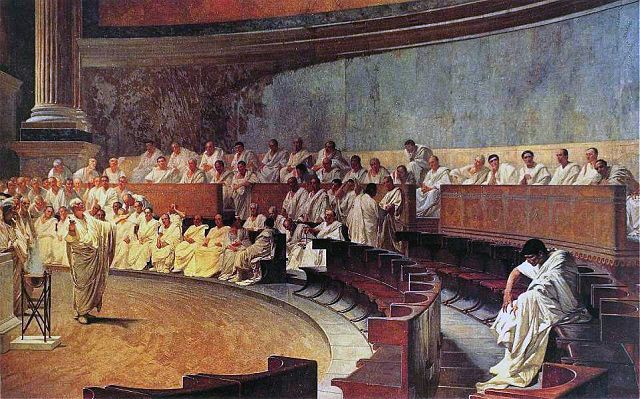
Religion
The Roman people considered themselves to be very religious. Religious beliefs and practices helped establish stability and social order among the Romans during the reign of Romulus and the period of the legendary kings. Some of the highest religious offices, such as the Pontifex Maximus, the head of the state’s religion— which eventually became one of the titles of the emperor—were sought-after political positions. Women who became Vestal Virgins served the goddess of the hearth, Vesta, and received a high degree of autonomy within the state, including rights that other women would never receive.
The Roman pantheon corresponded to the Etruscan and Greek deities. Jupiter was considered the most powerful and important of all the Gods, corresponding to the Greek’s Zeus. In nearly every Roman city, there was a central temple known as the Capitolia that was dedicated to the supreme triad of deities: Jupiter, Juno, and Minerva (Zeus, Hera, and Athena). Small household gods, known as Lares, were also popular.
Roman religious practice often centered around prayers, vows, oaths, and sacrifice. Many Romans looked to the gods for protection and would complete a promise sacrifice or offering as thanks when their wishes were fulfilled. The Romans were not exclusive in their religious practices and easily participated in numerous rituals for different gods. Furthermore, the Romans readily absorbed foreign gods and cults into their pantheon. With the rise of imperial rule, the emperors were considered gods, and temples were built to many emperors upon their death. Their family members could also be deified, and the household gods of the emperor’s family were also incorporated into Roman worship.
The Republic
Roman Sculpture under the Republic
During the Roman Republic, members of all social classes used a variety of sculptural techniques to promote their distinguished social statuses.
Key Points
- Continuous narration arose during the Republic as a means of telling a story from beginning to end in a visual form. Art patrons used it on public monuments to celebrate their status in society.
- The patronage of public sculpture extended to freedmen, as seen in the massive and uniquely decorated tomb of Marcus Vergilius Eurysaces the Baker.
- Veristic portraiture depicts the subject in hyper- realism, wrinkles and individual facial characteristics are carefully formed in these images.
- Portraits of Pompey the Great and Julius Caesar set precedents for future imperial portraiture by quoting iconographic characteristics and introducing a likeness of the living imperator on coins.
- Death masks provided a means for a family to remember their ancestors as well as to remind others of the illustriousness of their ancestry.
Key Terms
- verism: The style of portraiture favored during the Roman Republic in which the subjects were portrayed in a super-realistic likeness; from the Latin word for true. Age was exaggerated for effect.
- continuous narration: A visual art technique that illustrates multiple scenes of a story within a single frame and without any separation between scenes and actions.
- Imperator: A Latin word meaning general or ruler; a title given to triumphant generals during the Republic.
Roman Art in the Republic
Early Roman art was influenced by the art of Greece and that of the neighboring Etruscans, themselves greatly influenced by their Greek trading partners. As the expanding Roman Republic began to conquer Greek territory, its official sculpture became largely an extension of the Hellenistic style, with its departure from the idealized body and flair for the dramatic. This is partly due to the large number of Greek sculptors working within Roman territory.
However, Roman sculpture during the Republic departed from the Greek traditions in several ways.
- It was the first to feature a new technique called continuous narration.
- Commoners, including freedmen, could commission public art and use it to cast their professions in a positive light.
- Portraiture throughout the Republic celebrated old age with its verism.
- In the closing decades of the Republic, Julius Caesar counteracted traditional propriety by becoming the first living person to place his own portrait on a coin.
In the examples that follow, the patrons use these techniques to promote their status in society.
Portraiture
Roman portraiture during the Republic is identified by its considerable realism, known as veristic portraiture. Verism refers to a hyper-realistic portrayal of the subject’s facial characteristics. The style originated from Hellenistic Greece; however, its use in the Roman Republic is due to Roman values, customs, and political life.
As with other forms of Roman art, portraiture borrowed certain details from Greek art but adapted these to their own needs. Veristic images often show their male subjects with receding hairlines, deep winkles, and even with warts. While the faces of the portraits often display incredible detail and likeness, the subjects’ bodies are idealized and do not correspond to the age shown in the face.

The Double Portrait of Gratidia M.L. Chrite and M. Gratidius Libanus is another example of verism. This double bust was originally mounted on a funeral crypt or tomb and is illustrative on several levels. The wife of the couple makes a gesture of familial belonging that we have already seen in Egyptian representations like that of Menkaure and a Queen. It was also a gesture from the Roman marriage ceremony. 1She is notably younger in appearance; perhaps she had her portrait done when she was a younger woman for use after her death at whatever age. Alternately, she may have been a second, younger wife. Or more likely, the tradition of verism in men to underscore age, wisdom, and service to the city was not valued in women. Son of an ex-slave, Gratidius Libanus draws attention to his mark of citizenship, his toga.
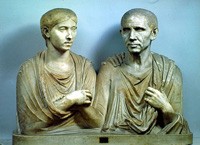

The popularity and usefulness of verism appears to derive from the need to have a recognizable image. Veristic portrait busts provided a means of reminding people of distinguished ancestors or of displaying one’s power, wisdom, experience, and authority. Statues were often erected of generals and elected officials in public forums—and a veristic image ensured that a passerby would recognize the person when they actually saw them.
The Late Republic
The use of veristic portraiture began to diminish in the first century BCE. During this time, civil wars threatened the empire, and individual men began to gain more power. The portraits of Pompey the Great and Julius Caesar, two political rivals who were also the most powerful generals in the Republic, began to change the style of the portraits and their use.
The portraits of Pompey are not fully idealized, nor were they created in the same veristic style of Republican senators. Pompey borrowed a specific parting and curl of his hair from Alexander the Great. This similarity served to link Pompey visually with the likeness of Alexander and to remind people that he possessed similar characteristics and qualities.
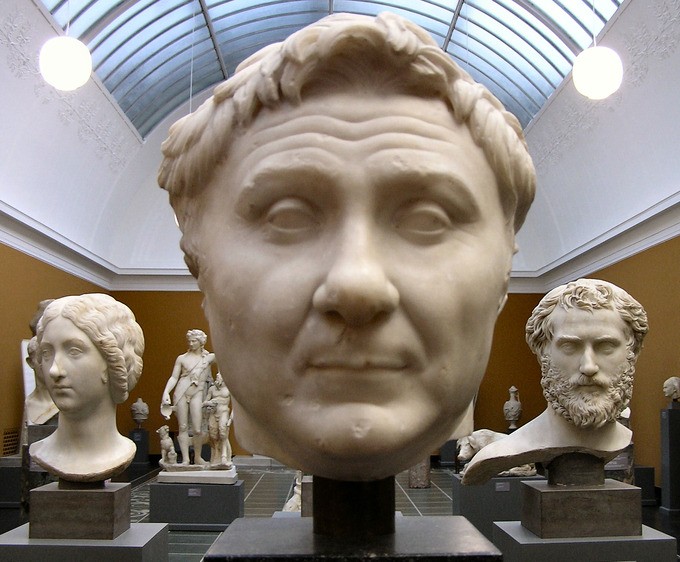
Death Masks
The creation and use of death masks demonstrate Romans’ veneration of their ancestors. These masks were created from molds taken of a person at the time of his or her death. Made of wax, bronze, marble, and terra cotta, death masks were kept by families and displayed in the atrium of their homes.
Visitors and clients who entered the home would have been reminded of the family’s ancestry and the honorable qualities of their ancestors. Such displays served to bolster the reputation and credibility of the family.
Death masks were also worn and paraded through the streets during funeral procession. Again, this served not only a memorial for the dead, but also to link the living members of a family to their illustrious ancestors in the eyes of the spectator. With the Empire which was ushered in with the elevation of Augustus Ceasar, verism became less important. Empirical portraiture was idealized with the ruler depicted as youthful and powerful.
The Empire
After the death of Julius Caesar at the hands of the Senators who believed him about to declare himself Emperor for life, Rome devolved into chaos for a time. Ironically, it took another strong man – Augustus Caesar – to actually declare himself Emperor to get Roman society back into line. The Empire stretched from 27 BC – 395 CE, then as a divided Empire with the Western rule in Italy from 395 -476/80 and Constantinople (present-day Istanbul) in the East from 395-1453 when it was conquered by Islamic peoples.
Sculpture in the Empire
Augustus Caesar ushered in a period of more than 100 years peace called the Pax Romana. He turned away from verism and was always pictured as young and vital. In this well-known sculpture, Augustus of Prima Porta, from the 1st century CE, the Emperor is shown as both a soldier and an orator, his armor decorated with images of Mars, the God of War, and barefoot as gods or heroes in classical sculpture are pictured. His upraised arm suggests the traditional pose of an orator and his body and facial features are idealized. At his feet is Cupic, son of Venus, the goddess Augustus reputedly was descended from. Emperors were elevated upon death to the position of a god. Here, Augustus’s sculpture is essentially political propaganda for the position of Emperor in a Rome previously hostile to that office. It is believed that this sculpture, like most ancient work, was painted in vivid polychromy.
Images of Emperors after Augustus followed this idealized format until late in the Empire. Eventually, figural types began to change and become more abstract opening the door to the conceptual images of medieval Christianity.

Architecture
Concrete
The Romans perfected the recipe for concrete during the third century BCE by mixing together water, lime, and pozzolana, volcanic ash mined from the countryside surrounding Mt. Vesuvius. Concrete became the primary building material for the Romans, and it is largely the reason that they were such successful builders.
Most Roman buildings were built with concrete and brick that was then covered in façade of stucco, expensive stone, or marble. Concrete was a cheaper and lighter material than most other stones used for construction. This helped the Romans build structures that were taller, more complicated, and quicker to build than any previous ones.
Once dried, concrete was also extremely strong, yet flexible enough to remain standing during moderate seismic activity. The Romans were even able to use concrete underwater, allowing them build harbors and breakers for their ports. The ruins of a tomb on the Via Appia (the most famous thoroughfare through ancient Rome) expose the stones and aggregate that the Romans used to mix concrete.
Arches, Vaults, and Domes
The Romans effectively combined concrete and the structural shape of the arch. These two elements became the foundations for most Roman structures. Arches can bear immense weight, as they are designed to redistribute weight from the top, to its sides, and down into the ground. While the Romans did not invent the arch, they were the first culture to manipulate it and rely on its shape.
An arch is a pure compression form. It can span a large area by resolving forces into compressive stresses (pushing downward) that, in turn, eliminate tensile stresses (pushing outward). As the forces in the arch are carried to the ground, the arch will push outward at the base (called thrust). As the height of the arch decreases, the outward thrust increases. In order to maintain arch action and prevent the arch from collapsing, the thrust needs to be restrained, either with internal ties or external bracing, such as abutments.
The arch is a shape that can be manipulated into a variety of forms that create unique architectural spaces. Multiple arches can be used together to create a vault. The simplest type is known as a barrel vault. Barrel vaults consist of a line of arches in a row that create the shape of a tunnel.
When two barrel vaults intersect at right angles, they create a groin vault. These are easily identified by the x-shape they create in the ceiling of the vault. Furthermore, because of the direction, the thrust is concentrated along this x-shape, so only the corners of a groin vault need to be grounded. This allows an architect or engineer to manipulate the space below the groin vault in a variety of ways.
Arches and vaults can be stacked and intersected with each other in a multitude of ways. One of the most important forms that they can create is the dome. This is essentially an arch that is rotated around a single point to create a large hemispherical vault. The largest dome constructed during the Republic was on the Temple of Echo at Baiae, named for its remarkable acoustic properties
The Pantheon
This Roman temple dedicated to all the Gods (pan – theis) was made possible by the Roman use of concrete. It was for centuries one of the most iconic structures in the world. See a very good video about the Pantheon here:
Flavian Amphitheater (Colosseum)
Upon his succession, the emperor Vespasian began a vast building program in Rome that was continued by Titus and Domitian. It was a cunning political scheme to garner support from the people of Rome.
Vespasian transformed land from hated emperor Nero’s Domus Aurea (Gold House) into public buildings for leisure and entertainment, such as the Baths of Titus and the Flavian Amphitheatre. Nero’s private lake was drained and became the foundations for the amphitheater, the first permanent amphitheater built in the city of Rome. Before this time, gladiatorial contests in the city were held in temporary wooden arenas.
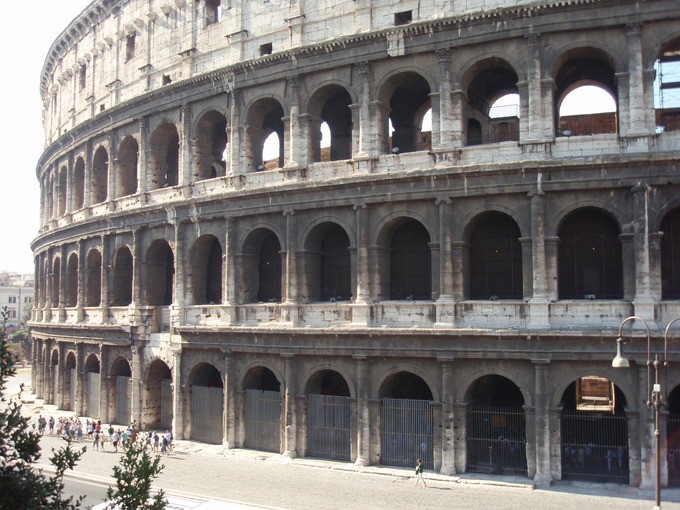
The amphitheater became known as the Colosseum for its size, but in also in reference to a colossal golden statue of Nero that stood nearby. Vespasian had the colossus reworked into an image of the sun god, Sol.
Painting in the Early Roman Empire
Roman frescoes were the primary method of interior decoration and their development is generally categorized into four different styles or periods. While it isn’t necessary to categorize each style, it is notable that examples of each remain in buildings preserved in Pompeii.
Key Points
- The development of fresco -painting styles is a visual example of the changing tastes from the third century BCE through the first century CE. The change in styles reflects the changes that occurred in Roman society.
Key Terms
- triclinium: Formal dining room.
- buon fresco: A painting that involves applying wet paint to wet lime plaster. As both components dry, a chemical reaction causes them to fuse together, literally making the painting part of the wall.
- encaustic: A wax-based paint that is fixed in place by heating; a painting produced using this paint.
- fresco: In painting, the technique of applying water-based pigment to lime mortar or plaster.
- Egyptomania: Roman fascination with all things related to Egypt following the death of Cleopatra in 31 BCE and the annexation of Egypt in 30 BCE.
- trompe l’oeil: A genre of still-life painting that exploits human vision to create the illusion that the subject of the painting is real.
Roman Painting
Roman painters often painted frescoes, specifically buon fresco, a technique that involved painting pigment on wet plaster. When the painting dried, the image became an integral part of the wall. Fresco painting was the primary method of decorating an interior space. However, few examples survive, and the majority of them are from the remains of Roman houses and villas around Mt. Vesuvius.
Other examples of frescoes come from locations that were buried (burial protected and preserved the frescoes), such as parts of Nero’s Domus Aurea and at the Villa of Livia. These frescoes demonstrate a wide variety of styles. Popular subjects include mythology, portraiture, still-life painting, and historical accounts.
The surviving Roman paintings reveal a high degree of sophistication. They employ visual techniques that include atmospheric and near one-point linear perspective to properly convey the idea of space. Furthermore, portraiture and still-life images demonstrate artistic talent when conveying real-life objects and likenesses. The attention to detail seen in still-life paintings include minute shadows and an attention to light to properly depict the material of the object, whether it be glass, food, ceramics, or animals.
Roman portraiture further exhibits the talent of Roman painters and often shows careful study on the artist’s part in the techniques used to portray individual faces and people. Some of the most interesting portraits come from Egypt, from late first century BCE to early third century CE, when Egypt was a province of Rome.
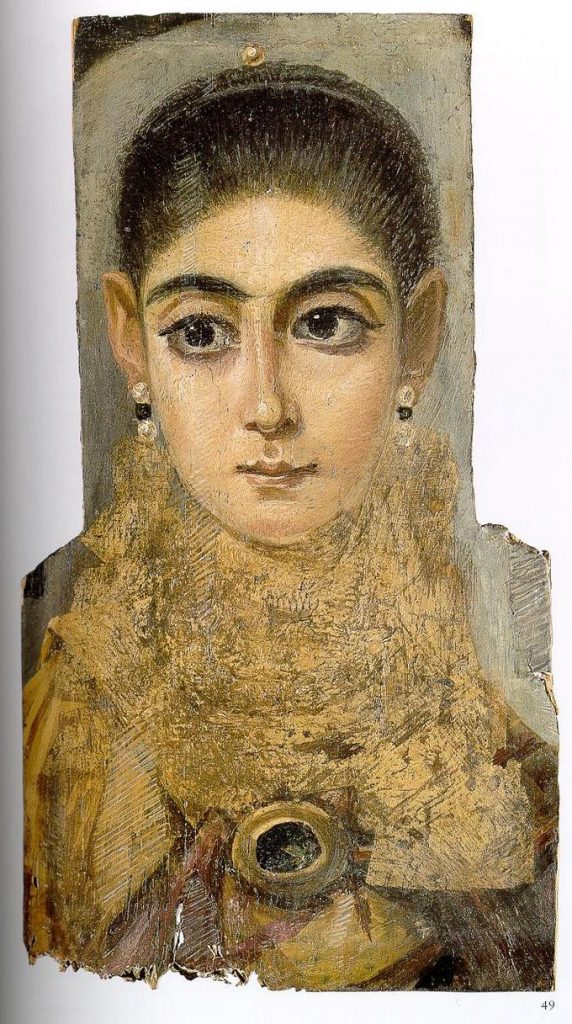
These encaustic-on-wood panel images from the Fayum necropolis were laid over the mummified body. They show remarkable realism, while conveying the ideals and changing fashions of the Egypto-Roman people.
Villa of the Mysteries
At the Villa of the Mysteries, just outside of Pompeii, there is a fantastic scene filled with life-size figures that depicts a ritual element from a Dionysian mystery cult. In this Second-Style example, architectural elements play a small role in creating the illusion of ritual space. The people and activity in the scene are the main focus. The architecture present is mainly piers or wall panels that divide the main scene into separate segments. The figures appear life-size, which brings them into the space of the room.

The scene wraps around the room, depicting what may be a rite of marriage. A woman is seen preparing her hair. She is surrounded by other women and cherubs while a figure, identified as Dionysus, waits. The ritual may reenact the marriage between Dionysus and Ariadne, the daughter of King Minos.
All the figures, except for Dionysus and one small boy, are female. The figures also appear to interact with one other from across the room. On the two walls in one corner, a woman reacts in terror to Dionysus and the mask over his head. On the opposite corner, a cherub appears to be whipping a woman on the adjoining wall. While the cult aspects of the ritual are unknown, the fresco demonstrates the ingenuity and inventiveness of Roman painters.
Pompeii
The eruption of Mount Vesuvius in 79 CE preserved many structures in the city of Pompeii, allowing scholars a rare glimpse into Roman life.
Key Points
- Pompeiian houses deviated greatly from the standard model created by historians. Examples demonstrate how the standard elements could be rearranged to fit almost any footprint and the wealth of the patron.
Key Terms
- atrium: A square hall lit by daylight from above, into which rooms open at one or more levels.
- peristyle: A colonnade that surrounds a courtyard, temple, etc.
- patrician: Originally, a member of any of the families constituting the populus Romanus, or body of Roman citizens, before the development of the plebeian order; later, one who, by right of birth or by special privilege conferred, belonged to the senior class of Romans, who, with certain property, had by right a seat in the Roman Senate.
During the Roman Republic and into the early Empire, the area today known as the Bay of Naples was developed as a resort-type area for elite Romans to escape the pressure and politics of Rome. The region was dominated by Mt. Vesuvius, which famously erupted in August 79 CE, burying and preserving the cities of Herculaneum and Pompeii, along with the region’s villas and farms.
When Vesuvius erupted on August 25, a cloud of ash spewed south, burying the cities of Pompeii, Nuceria, and Stabiae. While not everyone left prior to the eruption, archaeological evidence shows that people did leave the city. Some houses give the impression of having been packed up and in some cases furniture and objects were excavated jumbled together. Other objects of value appear to have been buried or hidden. There is evidence of people returning after the eruption to dig through the remains—either recovering lost goods or looting for valuables.
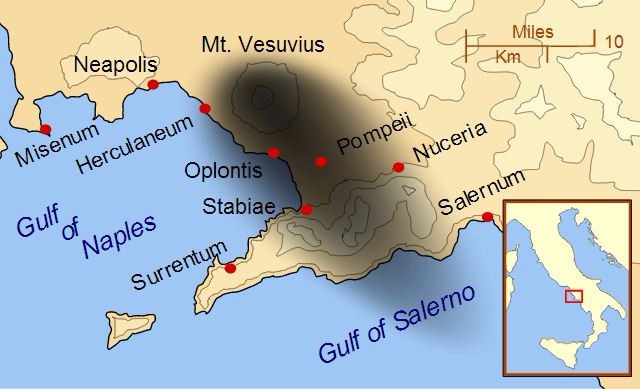
In Pompeii, an ash flow suffocated the remaining population and allowed all organic matter to decompose. However, where bodies and other organic objects (from bodies to wooden architectural frames) once lay or stood, empty cavities within the ash remained and preserved their outer forms.
A pyroclastic flow of superheated gas and rock went west to the coast and the city of Herculaneum. Unlike the ash blanket of Pompeii, the pyroclastic flow in Herculaneum petrified organic material, ensuring the preservation of human remains and wood, including the preservation of wooden screens, beds, and shelving. Many of the frescoes, mosaics, and other non-organic materials in both the ash and pyroclastic flows were preserved until their excavation in the modern period.
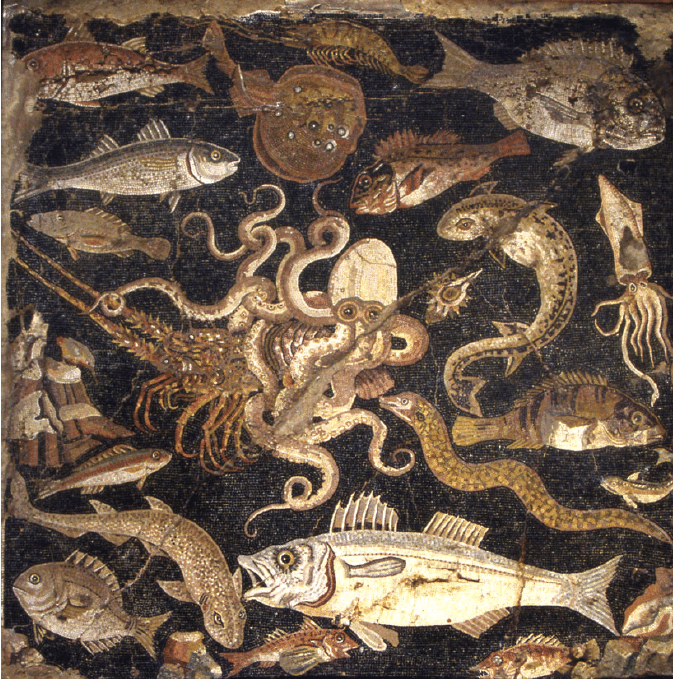
Returning to images from Fayum in Egypt, the mummy case of Artemidoros, 100 – 200 CE, shows the conflation of cultures at the end of the Roman period.
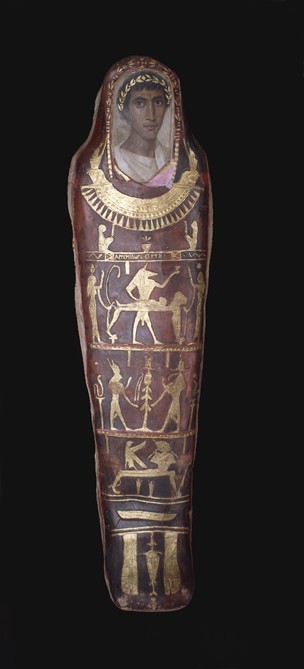
The image of the young man is done in a Roman style; his name is Greek and he wears a Greek victory wreath, yet his mummy case is covered in traditional Egyptian burial symbols. Rome’s influence would end with the rise of a new religion and that will be where we will turn our attention next.

